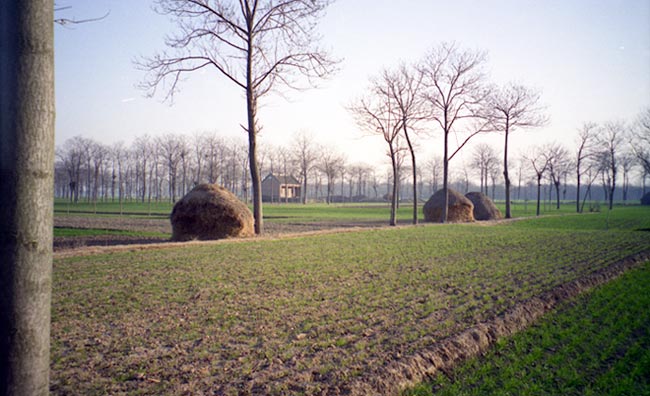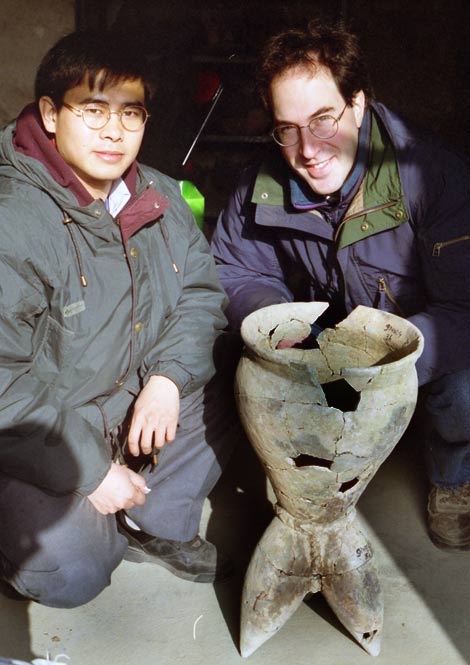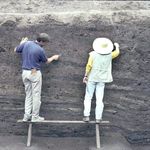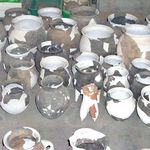Excavations: Shantaisi 山台寺
 The Shantaisi 山台寺 Site (Zhecheng County 柘城县) was excavated over five field seasons from 1995-1997, with an area of over 350 square meters opened. The Shantaisi site is primarily a deep and extremely rich late Neolithic occupation of the regional Longshan culture phase known as the Wangyoufang 王油坊 Type.
The Shantaisi 山台寺 Site (Zhecheng County 柘城县) was excavated over five field seasons from 1995-1997, with an area of over 350 square meters opened. The Shantaisi site is primarily a deep and extremely rich late Neolithic occupation of the regional Longshan culture phase known as the Wangyoufang 王油坊 Type.
Major Longshan Culture discoveries at Shantaisi include a large structure (F2) with a row of at least six connected rooms, white plastered floors and walls, and ceremonial caches of ceramic vessels, antler, animal bones, stone tools, and shells, as well as child burials, related to the various construction phases of the floors and walls. This structure was built upon a rammed earth platform, which itself had been constructed upon an earlier rammed earth platform.
 A second major discovery at Shantaisi was a Longshan period pit (H39) containing skeletons of at least nine cattle and the cranium of one muntjac deer. The pit was most likely used for offering a cattle sacrifice, and it might be the earliest such sacrificial pit found in China. Cattle sacrifice became a quintessential part of elite Shang ritual practices in which the Shang kings offered cattle to their ancestors. The Shang rituals are known through Shang oracle bone inscriptions and from cattle pits excavated at the last Shang capital at Anyang as well as at the Shang culture site of Xiaoshuangqiao 小双桥 in Zhengzhou 郑州, Henan. Since cattle pits are not found in pre-Shang period contexts in other regions, the Shantaisi pit is another clue that the Shang may have had their origins in this eastern region.
A second major discovery at Shantaisi was a Longshan period pit (H39) containing skeletons of at least nine cattle and the cranium of one muntjac deer. The pit was most likely used for offering a cattle sacrifice, and it might be the earliest such sacrificial pit found in China. Cattle sacrifice became a quintessential part of elite Shang ritual practices in which the Shang kings offered cattle to their ancestors. The Shang rituals are known through Shang oracle bone inscriptions and from cattle pits excavated at the last Shang capital at Anyang as well as at the Shang culture site of Xiaoshuangqiao 小双桥 in Zhengzhou 郑州, Henan. Since cattle pits are not found in pre-Shang period contexts in other regions, the Shantaisi pit is another clue that the Shang may have had their origins in this eastern region.
 Well over 100,000 Longshan period pottery sherds were recovered from Shantaisi, and over 400 ceramic vessels have been reconstructed. Tools include stone arrowheads, shovels, and adzes; shell knives and sickles; bone arrowheads, awls, and darts; and ceramic spindle whorls. Many faunal remains were also found at the site and include domesticated pig, cattle, dog, sheep, and goat, and wild fauna such as red deer, deer, turtle, and a large number of fish bones. The site also contained many well-preserved carbonized botanical remains. Flotation samples, analyzed by Prof. Gary Crawford and Dr. Gyoung-Ah Lee at the University of Toronto, contained a wide variety of wild and domesticated grasses, with both foxtail and broomcorn millet, as well as small beans, including soybean.
Well over 100,000 Longshan period pottery sherds were recovered from Shantaisi, and over 400 ceramic vessels have been reconstructed. Tools include stone arrowheads, shovels, and adzes; shell knives and sickles; bone arrowheads, awls, and darts; and ceramic spindle whorls. Many faunal remains were also found at the site and include domesticated pig, cattle, dog, sheep, and goat, and wild fauna such as red deer, deer, turtle, and a large number of fish bones. The site also contained many well-preserved carbonized botanical remains. Flotation samples, analyzed by Prof. Gary Crawford and Dr. Gyoung-Ah Lee at the University of Toronto, contained a wide variety of wild and domesticated grasses, with both foxtail and broomcorn millet, as well as small beans, including soybean.
Previous: Excavations: Mazhuang | Next: Discovery of a Lost City: City Song






